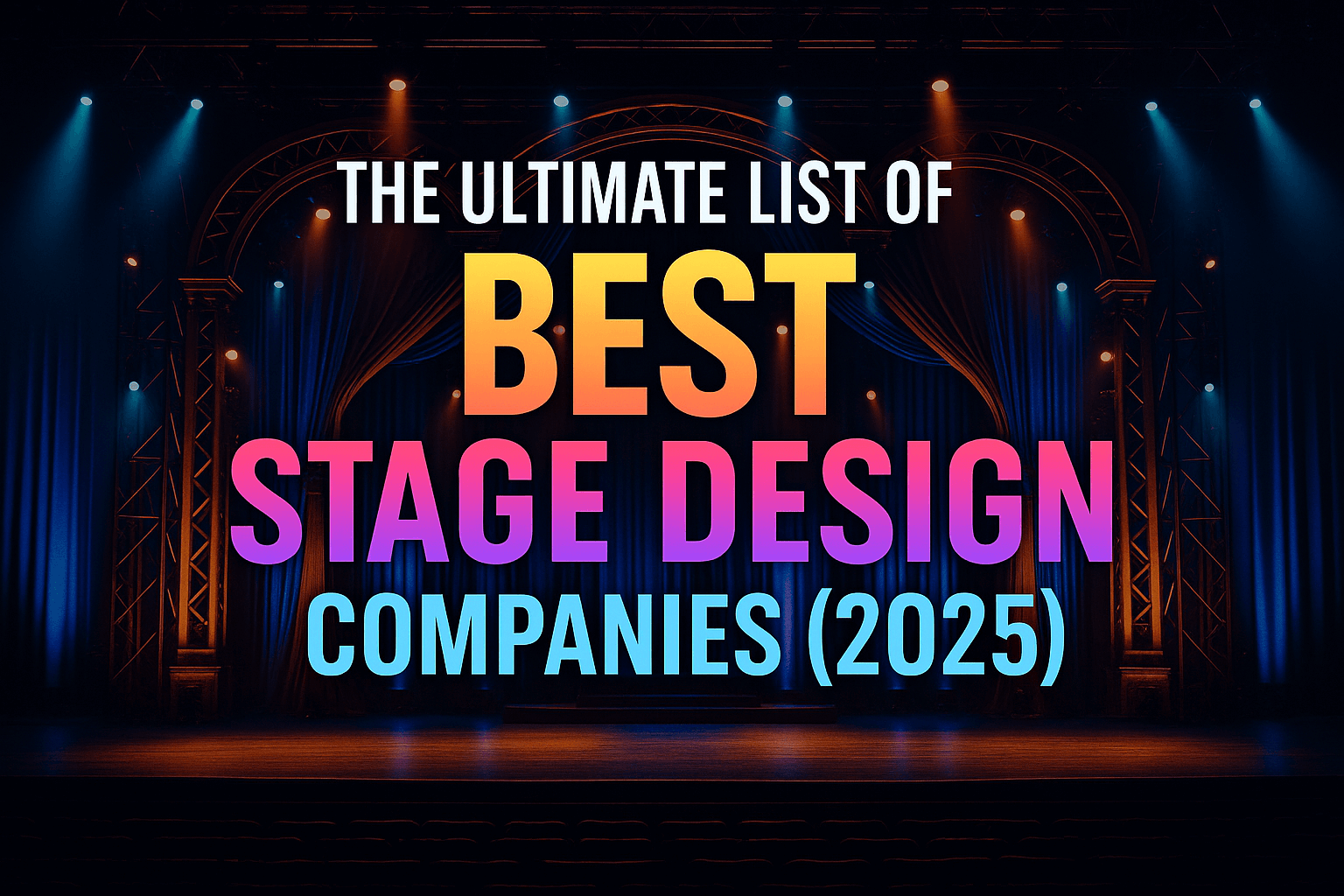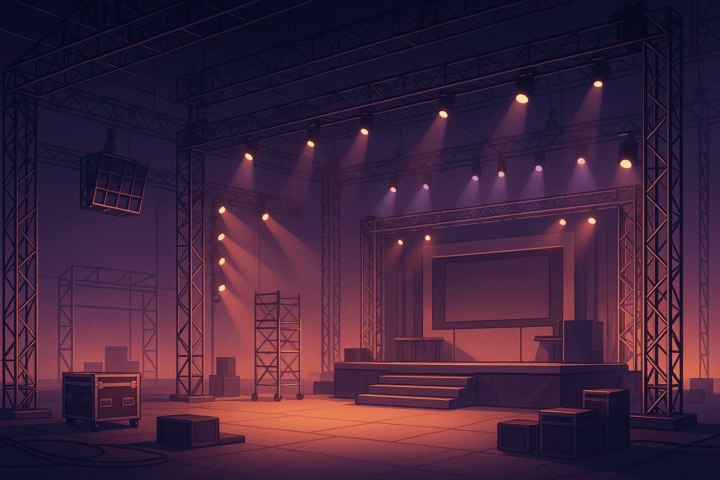The Ultimate List of Best Stage Design Companies (2025)

Introduction
The procurement of high-caliber production services is arguably the single most critical factor determining a media project’s success, yet the process of partner selection remains notoriously opaque and fragmented.
For the M&E executive focused on complex physical production—from world-building film sets to expansive live broadcast stages—finding a truly capable and reliable partner is a significant burden.
This is precisely why we have compiled The Ultimate List of Best Stage Design Companies—or, more accurately, the elite studios and content owners that commission, procure, and utilize the world’s most advanced stage assets.
We frame this topic not around small vendor lists, but around the major M&E players who set the market standard for scale and technical complexity.
By analyzing the global leaders in content ownership and production, we can reverse-engineer the criteria necessary for a successful service partner engagement, providing you with a strategic framework for vetting your next crucial supply chain partner.
Table of content
- Setting the Stage: The Evolving Landscape of Stage Design Procurement
- Our Evaluation Framework for Elite Stage Design Procurement
- The Top 10 Stage Production Companies: A Curated List
- How to Integrate These Partners into Your M&E Supply Chain
- How Vitrina Helps You Vet the Best Stage Design Companies
- Conclusion: Making Smarter Procurement Decisions
- Frequently Asked Questions
Key Takeaways
| Core Challenge | The global M&E supply chain for stage and production services lacks transparent, centralized data for executive-level sourcing and due diligence. |
| Strategic Solution | Evaluate elite studio clients—those with the highest production standards—to establish the technical and operational benchmarks for service provider quality. |
| Vitrina’s Role | Providing the deep market intelligence, verified project history, and executive contacts needed to effectively vet and engage these world-class production partners. |
Setting the Stage: The Evolving Landscape of Stage Design Procurement

The modern production landscape, driven by massive streaming budgets and a relentless demand for spectacle, has transformed the stage design and scenery market from a niche service into a sophisticated industrial procurement segment.
This is no longer simply about theatrical flats; it involves complex physical production infrastructure, including virtual production stages, automated rigging systems, and large-scale architectural set construction.
The shift is validated by market data: the Stage Art Design market alone was valued at $429.38 million in 2023 and is projected to reach $719.22 million by 2032, growing at a Compound Annual Growth Rate (CAGR) of 5.5% during the forecast period, according to a report from Global Growth Insights.
Driving this growth is the convergence of physical and digital techniques. Production companies now require vendors to be fluent in techniques like Extended Reality (XR) and Virtual Production, utilizing massive LED volumes and real-time graphics engines to execute world-building with technical precision.
Furthermore, the overall Entertainment Production Market size was valued at $99.98 Billion in 2024 and is projected to expand at a CAGR of 12.7% through 2032, highlighting the increasing financial commitment to content creation that requires high-quality stage and set design services, as reported by Future Data Stats.
For M&E executives, the core challenge is not just finding a fabrication partner, but finding an entertainment supply chain partner capable of delivering physical quality, technical readiness, and financial reliability at global scale.
This strategic imperative necessitates a data-driven approach to procurement that can verify a vendor’s actual experience in these technologically demanding areas.
Our Evaluation Framework for Elite Stage Design Procurement
When evaluating a partner for mission-critical physical production, M&E executives must move beyond subjective portfolios. The core of your strategic due diligence should focus on criteria that mirror the operational requirements of the major studios listed below.
This framework builds authority by focusing on the operational requirements of the film studio procurement process itself, which is often focused on mitigating risk and ensuring scale.
- Global Scale and Financial Health: A potential partner must demonstrate the financial stability and logistical capacity to undertake multi-million dollar, multi-jurisdictional set construction and deployment. Verifying a vendor’s ownership and financial track record is a primary defense against mid-project failure, a core concern for any executive focused on M&E production services.
- Technological Competency (Virtual Production): The partner must possess a proven history in contemporary stage design, specifically the integration of virtual and augmented reality elements, LED volumes, and complex motion control or automated rigging systems. This is the key differentiator between traditional set builders and future-proof production partners.
- Verifiable Project Alignment: Due diligence must confirm a match between the vendor’s experience and your project’s format (e.g., live broadcast, prestige feature film, large-scale reality show). A partner’s project history, found through an M&E Project Tracker, must show direct, high-level collaboration with companies that have similar production standards to those in our curated list.
- Security and IP Compliance: Because physical sets often house proprietary technology or early IP concepts, a capable partner must demonstrate stringent security protocols for both the physical location and the associated digital assets. This is non-negotiable when dealing with high-value content.
The Top 10 Stage Production Companies: A Curated List
The companies below represent the highest tier of global media enterprise—the content owners and studios that continuously drive demand for the world’s most advanced stage production and set design capabilities.
Evaluating your potential vendors against the standards of these industry leaders is a critical step in de-risking your own production strategy. By studying their verified production histories on Vitrina, executives can benchmark procurement expectations and identify the most qualified partners for complex stage design engagements.
-
Netflix
As the dominant global streaming platform, Netflix’s production infrastructure spans continents—from Albuquerque and Toronto to Madrid and Seoul. Its high-volume, multi-genre content slate demands partners who can deliver technically robust and scalable stage solutions. Vendors must demonstrate expertise in both traditional construction and next-generation virtual production environments.
-
The Walt Disney Company
Disney’s stage production requirements are defined by its IP-centric storytelling across Marvel, Pixar, and Lucasfilm properties. Its vendors are expected to execute high-concept, secure, and intricately detailed scenic environments that integrate seamlessly with complex VFX and virtual set technologies, often across multi-unit international shoots.
-
Warner Bros Discovery
Warner Bros Discovery combines a legacy of classic studio filmmaking with cutting-edge virtual production initiatives. Its facilities, from Burbank to Leavesden, are continuously modernized to accommodate large-scale features and high-end episodic work. WBD’s partners are chosen for their technical innovation, cost efficiency, and ability to integrate digital and physical stage solutions.
-
WildBrain
WildBrain, a leader in children’s and family entertainment, often requires highly specialized production environments—ranging from stop-motion facilities to small-scale sound stages for live-action series. Their procurement emphasizes creative precision, technical safety, and efficient use of constrained physical spaces for child-focused productions.
-
NTV
As one of Russia’s largest television broadcasters, NTV operates at high capacity across news, entertainment, and scripted formats. Its production demands focus on reliability and durability, requiring stage systems designed for continuous operation and rapid set turnover in high-throughput studio environments.
-
Gaumont
Gaumont is one of the world’s oldest film studios and continues to blend traditional European scenic craftsmanship with cutting-edge technical design. Its global co-production footprint requires stage partners skilled in international collaboration, compliance, and adaptive design across diverse cultural and regulatory frameworks.
-
RTBF
As Belgium’s French-language public broadcaster, RTBF manages a wide range of live broadcast and entertainment productions. Its procurement emphasizes regulatory compliance, public value, and long-term durability in stage design, prioritizing vendors who deliver cost-effective, reliable, and environmentally sustainable studio infrastructure.
-
Fremantle
Fremantle is a global production and distribution powerhouse specializing in large-scale, non-scripted entertainment formats such as Got Talent and Idol. Its stage production partners must deliver rapid-deployment, high-visibility builds across territories, supporting repeatable quality and strict format replication standards.
-
Lionsgate
Lionsgate’s dual focus on major film franchises and episodic television drives demand for partners capable of handling high-budget, complex productions. Their procurement criteria prioritize cost transparency, scalability, and integration with modern post-production and visual effects workflows across global production hubs.
-
CJ ENM Co.
CJ ENM, one of Asia’s most advanced entertainment conglomerates, has invested in large-scale facilities such as the CJ ENM Studio Center in Paju. With over a dozen sound stages integrated with XR and virtual production systems, CJ ENM partners exclusively with vendors that meet the highest global technical and creative standards in stage engineering.
How to Integrate These Partners into Your M&E Supply Chain
The tactical challenge for an M&E executive is not merely finding a list of names, but conducting thorough due diligence to move from a list of potential stage design companies to a binding, de-risked contract.
The successful integration of elite production partners into your supply chain requires a strategic, phased approach that moves beyond traditional Request for Proposal (RFP) processes.
- Phase 1: Deep Profile Vetting and Project Mapping: Before issuing an RFP, your team must confirm the candidate’s verifiable history. Do not rely on self-reported case studies; use platform-level intelligence to map a vendor’s recent collaborations with major studios like Netflix or Lionsgate. If a potential vendor claims to specialize in virtual production, you must verify their participation in projects that verifiably utilized LED volume stages. This process ensures their claimed expertise aligns with the technical complexity of your needs.
- Phase 2: Executive-to-Executive Mapping: In the M&E supply chain, deals are driven by relationships. Use tools that allow you to identify the precise executive—the Head of Production, the VP of Studio Operations, or the co-producer—within a company who has historically signed off on similar production service deals. Targeting the actual decision-maker shortens the procurement cycle and ensures your outreach is relevant, allowing you to bypass typical gatekeepers.
- Phase 3: Geographic and Regulatory Risk Assessment: For global co-production and filming, you must confirm a partner’s operational capability and compliance in the required jurisdiction. Check their legal entities, local labor compliance history, and network of local sub-vendors (especially critical when dealing with partners in non-Western territories like NTV or CJ ENM).This visibility is central to reducing legal and logistical friction for cross-border projects. Failure to execute this step can lead to massive cost overruns and delays, illustrating the keypain points in cross-border transactions: reputation and credentials.
A structured approach to M&E production service providers selection must rely on data that is current, global, and verified.
How Vitrina Helps You Vet the Best Stage Design Companies
Vitrina serves as the indispensable intelligence layer for M&E production procurement. We fundamentally solve the pain points inherent in vetting stage design companies and other service providers, aligning your strategic intelligence with your procurement needs.
- Verified Project History: Vitrina is the global leader in tracking the entertainment supply chain—film & TV content, projects, companies, collaborations, and decision-makers. The platform provides a transparent view of a partner’s complete, verified history, allowing you to ascertain their exact experience with specific production methods, locations, and studios (including all 10 companies listed above). The use of the Vitrina Production Vetting Solution transforms service selection from a manual audit into an automated, data-backed assessment.
- Executive Search and Contact Details: The platform features an extensive executive/person search function, indexing over 3 million CXOs and crew-heads tagged by department and specialization. This ensures you can directly connect with the correct decision-makers, eliminating inefficient cold outreach to the wrong departments and accelerating the partnership process.
- Mitigation of Reputational Risk: By providing transparent data on collaboration track records, deal history, and company ownership, Vitrina directly addresses the core challenge of fragmented and unverifiable partner information. This visibility allows M&E executives to move forward with partners based on proven performance, rather than promotional claims, significantly de-risking high-value production contracts.
Conclusion: Making Smarter Procurement Decisions
The selection of stage design companies is no longer a creative-only decision; it is a critical supply chain and financial risk management function. For senior M&E executives, success hinges on the ability to move swiftly from market identification to confident procurement.
By understanding the high standards set by major players like Netflix, Warner Bros Discovery, and CJ ENM Co., and by leveraging modern intelligence platforms like Vitrina, you can bypass the fragmented, opaque, and inefficient sourcing methods that plague the industry.
Our strategic recommendation is clear: transform your due diligence from an exercise in document gathering into a definitive, data-backed assessment of capability and compatibility. The future of production requires the verifiable data only a dedicated, M&E-specific platform can provide.
Frequently Asked Questions
Virtual production is a process that uses technologies like LED walls and real-time game engines to create digital backgrounds that interact with physical actors and sets. It requires stage design companies to shift from simple fabrication to complex technical integration, including specialized flooring, advanced camera tracking, and massive LED volume construction.
Major content owners set the global standard for scale, technical complexity, and financial reliability in the production ecosystem. Vetting a service provider against the standards required by these high-tier clients provides a reliable benchmark for capability, compliance, and experience in high-stakes projects.
The three most critical technical criteria are proven expertise in LED volume integration, verifiable experience with motion control or automated rigging systems (crucial for large sets), and the ability to integrate production design with post-production pipelines for seamless digital extensions.
The Entertainment Production Market’s projected growth of 12.7% CAGR through 2032 drives increased competition and demand for sophisticated, large-scale production facilities globally. This requires procurement executives to find vendors who can quickly scale up operations while maintaining high quality and cost efficiency.

























